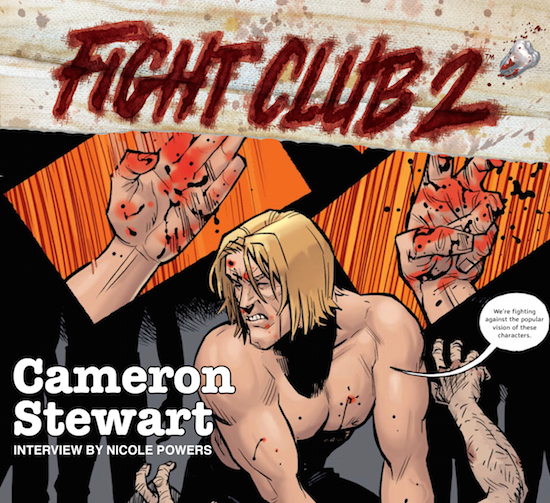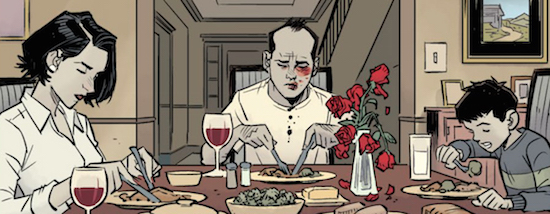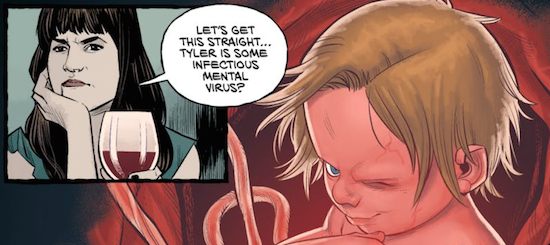
NEW SG Interview: Cameron Stewart — Fight Club 20
Posted In Blog,Books,Comics,Entertainment,Favorites,Interviews,Movies

It’s hard enough when a beloved book is made into a film for a director to overcome people’s preconceived notions of the characters. But when you’re working on the visual elements of a project that’s based on a cult-turned-contemporary classic book that’s been made into an acclaimed and highly stylized film, it’s exponentially harder to compete with the cherished visions people hold in their head. And when you factor in that the protagonist in the movie was played by Brad Pitt at peak cool, improving on veritable perfection is nigh on impossible.
That’s the challenge comic artist Cameron Stewart faced when he got the gig to turn Fight Club, which was first a book written by Chuck Palahniuk and then a film directed by David Fincher, into a comic series — a concept in and of itself that many deemed to be inconceivable when Palahniuk first announced it. Such an endeavor could only be accomplished by a true comic book superhero, and Stewart certainly qualifies as one. The multi-award winning artist has a résumé that includes Batgirl, Catwoman, Scooby Doo, Seaguy, Batman & Robin, Assassin’s Creed, Amazing X-Men, and Guardians of the Galaxy, to name but a few. He also just happens to be the man responsible for transforming SuicideGirls into comic form!
We caught up with Stewart to talk about Fight Club 2 just after its release as a hardcover graphic novel. Stewart, who was busy packing for a transatlantic move from Glasgow back to his hometown of Toronto, was kind enough to take our call.
Read the full interview on SuicideGirls.com/.
Nicole Powers: How did your involvement in Fight Club 2 come about?
Cameron Stewart: I had heard about it at the same time everyone else did when Chuck announced it at a panel at San Diego Comic Con, in I think 2013. At first I was kind of baffled by it. [I thought] it was a very odd idea for there to be a sequel at all, let alone for it to be done as a comic book. But the more I thought about it, I thought it was interesting. And I found it was possibly going to be published by Dark Horse. I have a history with Dark Horse. I did B.P.R.D. with them and they published my graphic novel as well, Sin Título. So I called the editor-in-chief there, Scott Allie, and I was like: ‘Are you doing this Fight Club book? And if so, I think I want to do it…’ He was into the idea, but he also was like, it’s Chuck’s, he has the final say… I ended up doing an audition piece, where I took a chapter from the original novel that was different from the film and I adapted that to a comic. It was just a little three-page thing… A proof of concept where I could show them, if I drew it, it would probably look something like this…That was enough to A, prove my commitment to it, and B, to give Chuck a visual sense of what I would do. And that’s how it happened. That’s how I got the gig.
NP: How did you and Chuck start working together? Was it an email thing? A phone thing? Or in-person?
CS: It was in person. Actually, one of the big sticking points about working on the book was just that they would have preferred somebody who was local to Portland, because that’s where Chuck lives. I was living in Berlin at the time. At this point I really wanted the job and I didn’t want to [be passed over for] something as stupid as geography, so I actually said, okay, I’ll move to Portland for the summer.
I packed up and rented a house in Portland… So we were able to get together, the whole team. It was me and Chuck and Scott and Dave Stewart, our colorist, and Nate Piekos, who is our letterer and the book designer. We would have these meetings where we would talk it over and experiment with ideas, you know, spitball ideas for different visual things that we could do. So, yeah, it began as a very in-person thing. I could sketch out ideas right on the spot… What does Tyler look like? What kind of hair does he have? I would sketch out little ideas and Chuck would point to the ones he liked.
NP: When I spoke to Chuck, he mentioned he’d written the whole thing in advance because he wanted you to have an idea of what characters and settings to concentrate on and prioritize. Was the entire thing written by the time you came to Portland?
CS: It was. In fact, I arrived and I was handed the whole thing in a big folder — the whole ten issue script… I’ve never had that ever, where a script was done in full up front. Initially it was cool to be able to get to read the entire thing and have a sense of what it was. It actually ended up being a first draft — well by that point it might have been a second or third — but it went through additional revisions as we were working on it. Chuck had different ideas and he was inspired by some of the stuff I was doing, so he ended up changing some things as we went along.
NP: He mentioned that the final book is something like a fifth draft. How did it change through the drafts?
CS: He changed some of the direction of the story and I think at first he did not include a lot of the characters from the original novel… Because a lot of the really passionate Fight Club fans were asking if certain characters would be coming back and I think he reconsidered it and thought, well, okay, maybe we will bring them back. So he included some of the characters like Angel Face, that I think in the original draft, weren’t present. And we made the ending a lot more extreme. I don’t want to say too much in case someone reading the interview hasn’t read the book yet, but the very final pages of the book are different than the original plan.
NP: Oh, that’s intriguing. I’d love to know what the original ending was, just because I’m a geek like that.
CS: The notion of Chuck getting killed by Tyler, it wasn’t in the original draft, that came in much later.

NP: What kind of guidance were you given by Chuck initially when you started work on drawing Fight Club 2?
CS: We just had a couple of discussions about his vision of what the characters should look like and where they were at this particular stage in their lives. Marla and Sebastian, they’re now middle-aged, and they’ve been married for a while, and they have a child together. Sebastian is still the office drone with the shirt and tie, but Marla is less punk/goth than she was originally portrayed. She’s now a middle-aged woman wearing Prada and Gucci handbags… pantsuits and stuff… less of a rat’s nest hair and more coiffed. And then Tyler is portrayed to match more like he is in the original novel. The popular image of Tyler is Brad Pitt, with the scruffy goatee and the spiky hair… In the book, he was always meant to just represent a better version of Sebastian. They would be wearing the same clothes, but whereas on Sebastian they would look rumpled and ill-fitting, Tyler would always look immaculately tailored. He was just meant to be extremely muscular and have long blond hair, like a male model. So we tried to do that and give him that kind of appearance, but also look kind of sinister and like a bully in a lot of ways. It’s a difficult thing, because we’re fighting against the popular vision of these characters from the film, and we’re not allowed to use those, partially because of the likeness rights of the actors, but also because anything related to the film is property of 20th Century Fox and we had to do something that was different than that. It was a challenge to have to do characters that were, at once, immediately recognizable, but also nothing like what people know them as.
NP: What was your first introduction to Fight Club? Was it through the book or through the movie?
CS: It was through the film, of course. I saw the movie and I really loved it, then I immediately sought out the novel. I read the novel and really enjoyed the novel as well. Then I became a fan of Chuck’s in particular… I think he only had two or three novels out at that point… Choke and Survivor. Subsequently, I haven’t read everything that he’s written, but I’ve read a good deal of it. I’ve probably read about eighty to ninety percent of what he’s written, so I’m a longtime fan.
NP: What appealed to you about Fight Club?
CS: First and foremost I think I thought it was really funny and really clever. I really enjoyed, in both the film and the novel, the interesting prose style that I don’t think I’d ever read anything like… Really short, sharp sentences that were really dry and sardonic and had this rhythm to them… I just found it a really intriguing book. And I loved the film just for its energy and visual style.
NP: Can you remember when you saw the film at which point you figured out the narrator and Tyler were one and the same?
CS: I didn’t. I was suckered in completely… I didn’t see it coming at all.
NP: It’s one of those films that you actually want to see again when you know the secret so you can see all the scenes in a different light.
CS: Yeah, it’s a movie — and a book too — where the reveal of the “twist” doesn’t actually spoil the movie for future viewings. It kind of enriches it. You get to see it from another perspective.

NP: I love what you guys have done with the comic, the way the end opens things up so you can take it in a new direction. With the book, you were left wondering who Tyler was, whereas with the comic, you’re left wondering what he is.
CS: I think, as most people interpret the book and the film, he’s just another personality of Sebastian’s, whereas the comic opens up the possibility that he’s much more than that. That he’s something that’s been around for a lot longer, some kind of malevolent force that has existed throughout time.
NP: That really opens the universe of Fight Club up through space and time.
CS: Yeah, absolutely. I think Chuck’s been quite inspired by that idea I know that he’s certainly toyed around with things. I don’t know what I can say, but I think he’s toyed with doing even more with this idea.
NP: I know that he’s already started working on Fight Club 3. Are you on the case as of yet?
CS: We talked about it. I know that both he and Dark Horse would like me to do it. I can’t right now. I told him I would be happy to do it, but… I’ve lived with it for two years and I need something to cleanse my palette, I guess, before coming back to it refreshed and anew. If we can do it a couple of years from now or something, I think I’m all on board.
NP: What are you currently working on? What are you doing for palette cleansing?
CS: Right now I’m doing a book with the team that I worked with on Bat Girl for Image Comics. It’s a creator-owned thing called Motor Crush. It’s a science fiction/action adventure comic about motorcycle gangs and a young woman who is a professional circuit racer who is forced to participate in these illegal street bike gang wars in order to gain possession of a machine narcotic called Crush, which is like an accelerant for bikes that amps them up, but it’s highly addictive to machinery.
NP: Have you any plans to work on another project that’s one hundred percent you?
CS:Yes. Absolutely. It’s something that I haven’t since doing my book, Sin Título. I’ve definitely wanted to get back into doing that. I have some ideas that are gestating at the moment and I want to do it. I really enjoy collaboration. It’s fun to team up with people who come from different perspectives and can maybe temper some of my own impulses. But there’s a particular satisfaction to doing something that’s of pure artistic expression that’s just yourself.
NP: What’s the source of some of your best ideas?
CS: Most of my strongest ideas just come from personal experience. Even if they’re ideas for stories or elements of the story that are in the realm of the fantastic and not exactly realistic, they’re still usually inspired by something that I’ve experienced directly or whatever… I think that hunting life experiences is the best thing that a writer could do… It’s the raw material that ideas are made out of.
Further Reading

